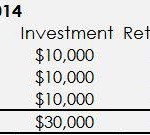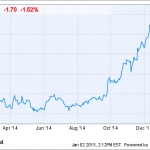These 3 Biotech Stocks Tripled Investors' Money in 2014

Life-changing financial gains are usually generated over the long haul, not in one year. However, sometimes stocks can put up eye-popping returns over a short period of time and when they do they can have a huge impact on investor’s portfolios. For example, these three healthcare stocks tripled investor’s money last year and while no one can know if they’ll post gains in 2015, understanding what made these stocks top performers may provide clues to discovering the market’s next big winners.
Source: Author’s calculations
1. OvaScience : up 384% in 2014 .
According to the Centers for Disease Control, about 6 million American women of child bearing age have difficulty getting or staying pregnant. As a result, many of these women turn to in vitro fertilization procedures in a bid to have children. However, those procedures, which can cost upward of $20,000 when the cost of related medicines and testing are included, only work about half the time.
The need for less costly and more effective approaches has led OvaScience to develop three next-generation fertility solutions that could significantly disrupt the in vitro market.
Previously, in vitro fertilization specialists used the mitochondria from other patient’s donor eggs to improve egg health, but OvaScience’s Augment approach does that by using mitochondria from the patient’s own precursor egg cells, which are found in the ovarian lining. Although Augment isn’t available in the United States, it is being tested in Canada, the United Kingdom, and other abroad markets. Those test locations are transitioning into commercial centers this year, so investors will want to see if these centers can generate meaningful revenue for the company in 2015. Also, OvaScience received two U.S. patents for Augment earlier this year, which may suggest that it’s simply a matter of time before Augment wins FDA support and becomes available in America too.
In addition to Augment, OvaScience is also developing OvaPrime, a fertility approach that increases a patient’s egg reserve by moving precursor egg cells from the ovarian lining to a patient’s ovaries. OvaPrime should launch in some international markets in 2015. OvaScience is also developing OvaTure, a process that allows for the maturing of a patient’s precursor egg cells outside the body, which could one day reduce or eliminate the need for hormone therapy.
Disrupting the fertility industry could prove to be a significant commercial opportunity for OvaScience, however, the company remains in the early stages with no meaningful revenue (yet). Regardless, OvaScience’s performance in 2014 suggests that investors shouldn’t be ignoring cutting edge technology that aim to improve existing markets.
Agios Therapeutics : Up 368% in 2014
Research into curing cancer is increasingly shifting toward personalized approaches that seek to treat specific genetic mutations in new ways. Agios is one of the companies that hopes to one day commercialize these next-generation anti-cancer approaches.
The company has two drugs in early stage trials that target mutations that change how cells metabolize fuel in order to grow. The company’s AG-221 and AG-220 are being studied as potential therapies for acute myeloid leukemia, or AML, a blood cancer. More than 18,000 Americans are diagnosed with AML every year and more than 10,000 people die from AML annually. Currently, AML treatment involves intensive chemotherapy, which comes with significant side-effects. However, most patients eventually see their cancer return and despite additional treatment, including stem-cell transplantation, the majority of patients fail to live beyond five years following their diagnosis.
AG-221 and AG-220 aim to change that by targeting a faulty gene that interferes with a cells metabolism and halts the maturation of blood cells. That mutation is found in roughly 15%-23% of AML patients. In phase 1 trials, 14 of 25 patients treated with AG-221 responded to the treatment, with six patients seeing a complete response. That’s a notable achievement given that over the past 20 years there’s been little progress in treating AML.
Agios thinks that AG-221 and AG-220 could eventually be used to treat other cancers that possess that same faulty gene too, including brain cancer, however, these are very early stage drugs and the number of patients treated by Agios so far is small. As a result, Agios efforts could ultimately fail in large, late stage trials. Regardless, Agios’ efforts in cell metabolism could mark a significant breakthrough in cancer treatment and that may indicate investors should continue to search out drugmakers that are working on personalized cancer therapies.
Bluebird bio : Up 337% in 2014
While Agios is researching ways to restore normal cell metabolism, Bluebird Bio is seeking to reengineer the body’s immune system to treat disease.
Bluebird’s Lenti-D modifies a patient’s stem cells to include a functioning version of a missing gene that is associated with childhood cerebral adrenoleukodystrophy, a rare genetic disease, and its LentiGlobin BB305 inserts a fully functional human beta-globin gene into patient stem cells to treat beta thalassemia major and severe sickle cell disease. Bluebird is also studying immunotherapy approaches that may allow the immune system to identify and kill cancer cells.
In 2014, Bluebird’s success stemmed primarily from early stage results for LentiGlobin BB305. In June, the company announced initial positive clinical trial data in beta-thalassemia major patients and in December, the company reported additional data showing that LentiGlobin BB305 successfully reduced or eliminated the need for blood transfusions that are typically necessary for those patients.
The results are encouraging given that 40,000 children are born with Beta-Thalassemia globally every year, however, results reflect just a handful of patients, so investors should take them with a grain of salt. Regardless, Bluebird’s BB305 trial is ongoing, which should mean that investors will gain additional insight this year. Bluebird’s performance this past year suggests that investors are highly interested in immunotherapy. If so, investors may want to consider some of Bluebird’s immunotherapy peers on their watch list this year too.
Connecting dots
Ovascience, Agios, and Bluebird are small-cap stocks without product revenue. That means they’re high-risk bets suitable only for the most risk-tolerant of us. Regardless, their share performance in 2014 suggests that investors willing to accept the risk of failure may want to focus on finding other small cap, game-changing companies across healthcare.
1 great healthcare stock to buy for 2015 and beyond
Healthcare stocks soared in 2014, and 2015 is shaping up to be another great year for stocks. But if you want to make sure you’re buying one of the best healthcare stocks, ;you need to know where to start. That’s why The Motley Fool’s chief investment officer just published a brand-new research report that reveals his top stock for the year ahead. To get the full story on this year’s stock — completely free ;– simply click here .
The article These 3 Biotech Stocks Tripled Investors’ Money in 2014 originally appeared on Fool.com.
Todd Campbell has no position in any stocks mentioned. Todd owns E.B. Capital Markets, LLC. E.B. Capital’s clients may or may not have positions in the companies mentioned. Todd owns Gundalow Advisors, LLC. Gundalow’s clients do not have positions in the companies mentioned. The Motley Fool has no position in any of the stocks mentioned. Try any of our Foolish newsletter services free for 30 days . We Fools may not all hold the same opinions, but we all believe that considering a diverse range of insights makes us better investors. The Motley Fool has a disclosure policy .
Copyright © 1995 – 2015 The Motley Fool, LLC. All rights reserved. The Motley Fool has a disclosure policy .
The views and opinions expressed herein are the views and opinions of the author and do not necessarily reflect those of The NASDAQ OMX Group, Inc.
Originally from –
These 3 Biotech Stocks Tripled Investors' Money in 2014


